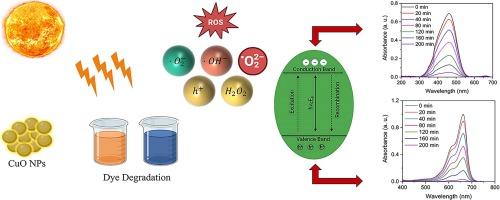利用石榴合成的 CuO 纳米粒子在阳光驱动下降解水污染物
IF 3.9
3区 材料科学
Q2 MATERIALS SCIENCE, MULTIDISCIPLINARY
引用次数: 0
摘要
由于氧化铜(CuO)纳米粒子具有显著较高的光催化活性,因此其环保且经济高效的绿色合成备受关注。在此,我们报告了利用石榴皮提取物绿色合成氧化铜纳米粒子的情况。研究发现,该纳米粒子对亚甲蓝(MB)和甲基橙(MO)染料的光催化降解效率分别为 98% 和 95%。即使经过四个周期的染料降解,CuO 纳米粒子的稳定性也超过了 90%。为了全面了解纳米粒子的结构、化学和光学特性,我们分别使用 X 射线衍射(XRD)、扫描电子显微镜(SEM)、傅立叶透射红外光谱(FTIR)和紫外-可见光谱对纳米粒子进行了系统表征。我们的研究结果表明,CuO 纳米粒子在工业废水处理方面具有巨大的潜力。本文章由计算机程序翻译,如有差异,请以英文原文为准。

Sunlight-driven degradation of water pollutants using pomegranate-synthesized CuO nanoparticles
Environmental-friendly and cost-effective green synthesis of Copper Oxide (CuO) nanoparticles has attracted great attention because of their significantly higher photocatalytic activity. Here, we report the green synthesis of CuO nanoparticles using an extract derived from Punica Granatum (Pomegranate) peels. It is found that the nanoparticles exhibit photocatalytic degradation efficiency of 98% and 95% for Methylene Blue (MB) and Methyl Orange (MO) dyes, respectively. The stability of CuO nanoparticles is more than 90% even after four cycles of dye degradation. The nanoparticles are systematically characterized using X-ray diffraction (XRD), Scanning Electron Microscope (SEM), Fourier Transmission Infrared Spectroscopy (FTIR), and UV–Visible spectroscopy for comprehensive understanding of structural, chemical, and optical properties, respectively. Our results suggest that the CuO nanoparticles show great potential for industrial wastewater treatment.
求助全文
通过发布文献求助,成功后即可免费获取论文全文。
去求助
来源期刊

Materials Science and Engineering: B
工程技术-材料科学:综合
CiteScore
5.60
自引率
2.80%
发文量
481
审稿时长
3.5 months
期刊介绍:
The journal provides an international medium for the publication of theoretical and experimental studies and reviews related to the electronic, electrochemical, ionic, magnetic, optical, and biosensing properties of solid state materials in bulk, thin film and particulate forms. Papers dealing with synthesis, processing, characterization, structure, physical properties and computational aspects of nano-crystalline, crystalline, amorphous and glassy forms of ceramics, semiconductors, layered insertion compounds, low-dimensional compounds and systems, fast-ion conductors, polymers and dielectrics are viewed as suitable for publication. Articles focused on nano-structured aspects of these advanced solid-state materials will also be considered suitable.
 求助内容:
求助内容: 应助结果提醒方式:
应助结果提醒方式:


